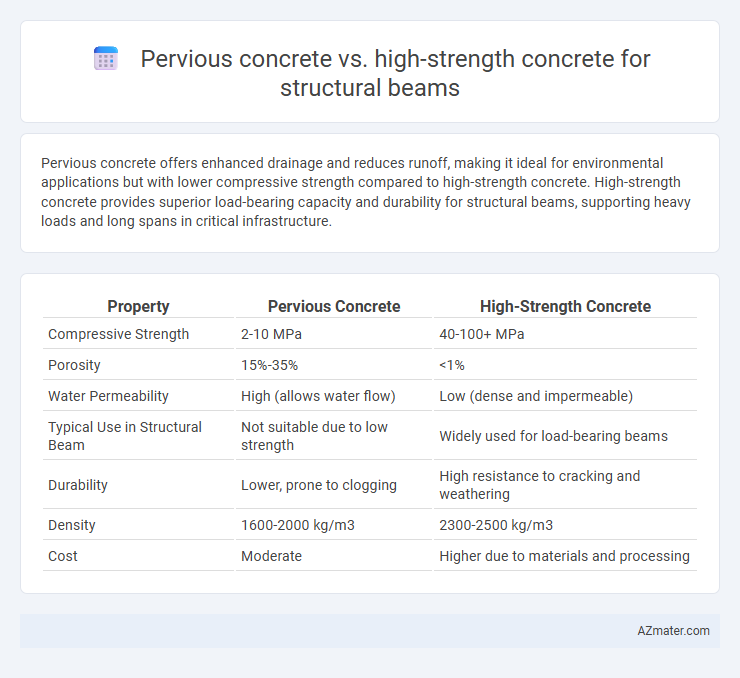Pervious concrete offers enhanced drainage and reduces runoff, making it ideal for environmental applications but with lower compressive strength compared to high-strength concrete. High-strength concrete provides superior load-bearing capacity and durability for structural beams, supporting heavy loads and long spans in critical infrastructure.
Table of Comparison
| Property | Pervious Concrete | High-Strength Concrete |
|---|---|---|
| Compressive Strength | 2-10 MPa | 40-100+ MPa |
| Porosity | 15%-35% | <1% |
| Water Permeability | High (allows water flow) | Low (dense and impermeable) |
| Typical Use in Structural Beam | Not suitable due to low strength | Widely used for load-bearing beams |
| Durability | Lower, prone to clogging | High resistance to cracking and weathering |
| Density | 1600-2000 kg/m3 | 2300-2500 kg/m3 |
| Cost | Moderate | Higher due to materials and processing |
Introduction to Pervious and High-Strength Concrete
Pervious concrete is a highly porous material designed to allow water infiltration, reducing runoff and promoting groundwater recharge, making it ideal for sustainable construction in structural applications like beams where drainage is necessary. High-strength concrete, characterized by compressive strengths exceeding 6,000 psi, offers enhanced load-bearing capacity and durability, crucial for structural beams in high-stress environments. Both types serve distinct purposes, with pervious concrete prioritizing permeability and water management, while high-strength concrete emphasizes mechanical performance and structural integrity.
Key Properties of Pervious Concrete
Pervious concrete is characterized by high porosity, allowing water to pass through effectively, which reduces runoff and enhances groundwater recharge, but it has lower compressive strength compared to high-strength concrete commonly used in structural beams. High-strength concrete, with compressive strength typically exceeding 6000 psi, offers superior load-bearing capacity and durability crucial for structural applications, whereas pervious concrete usually ranges from 1000 to 4000 psi. The key properties of pervious concrete include void content of 15-30%, permeability rates of 0.1 to 0.3 cm/s, and reduced density, making it less suitable for primary load-bearing beams but ideal for sustainable construction elements requiring drainage.
Essential Features of High-Strength Concrete
High-strength concrete for structural beams offers superior compressive strength typically above 6,000 psi, enabling slimmer, lighter beams with enhanced load-bearing capacity and durability. It provides reduced permeability and increased resistance to environmental factors such as corrosion and freeze-thaw cycles, ensuring longer service life in aggressive conditions. Compared to pervious concrete, high-strength concrete achieves higher modulus of elasticity and improved bonding with reinforcement, critical for structural integrity and performance in load-bearing applications.
Structural Performance in Beam Applications
Pervious concrete offers excellent permeability but generally exhibits lower compressive strength and reduced load-bearing capacity compared to high-strength concrete, which is engineered for superior structural performance in beam applications. High-strength concrete provides enhanced flexural strength, durability, and resistance to cracking, making it preferable for beams subjected to heavy loads and critical stress conditions. Structural beams made from high-strength concrete typically ensure improved safety and longevity in infrastructures such as bridges and high-rise buildings.
Load-Bearing Capacity Comparison
High-strength concrete exhibits significantly higher load-bearing capacity compared to pervious concrete due to its dense microstructure and elevated compressive strength, often exceeding 6000 psi. Pervious concrete, designed for permeability, has lower compressive strength, typically ranging from 2000 to 4000 psi, making it less suitable for critical structural beams subjected to heavy loads. Structural beams require the superior mechanical properties of high-strength concrete to ensure durability and safety in load-bearing applications.
Durability and Service Life of Beams
Pervious concrete offers enhanced drainage and reduces hydrostatic pressure, but its lower compressive strength and higher permeability can limit the durability and service life of structural beams compared to high-strength concrete. High-strength concrete provides superior compressive strength, reduced permeability, and improved resistance to chemical attacks and freeze-thaw cycles, resulting in longer-lasting beams with minimal maintenance requirements. For structural beams requiring enhanced durability and extended service life, high-strength concrete is generally preferred due to its robust mechanical properties and reduced susceptibility to environmental degradation.
Environmental Impact and Sustainability
Pervious concrete significantly reduces stormwater runoff by allowing water infiltration, promoting groundwater recharge and mitigating urban flooding, which enhances environmental sustainability compared to conventional high-strength concrete. High-strength concrete offers superior load-bearing capacity but typically involves higher cement content, leading to increased carbon emissions during production, thus presenting challenges in environmental impact reduction. Selecting pervious concrete for structural beams in non-critical load applications supports green infrastructure goals, while high-strength concrete remains essential where structural performance outweighs sustainability concerns.
Workability and Construction Challenges
Pervious concrete offers enhanced drainage and environmental benefits but poses workability challenges due to its high porosity, requiring careful placement and compaction to avoid segregation in structural beams. High-strength concrete provides superior load-bearing capacity and durability, yet it demands precise mix design and curing practices to prevent shrinkage and cracking during beam construction. Both types require specialized handling techniques, with pervious concrete necessitating rapid installation to maintain permeability and high-strength concrete needing strict quality control for optimal structural performance.
Cost Analysis: Pervious vs High-Strength Beams
Pervious concrete beams generally incur lower material costs due to reduced cement content and inclusion of porous aggregates, but may require increased maintenance and durability considerations, impacting long-term expenses. High-strength concrete beams involve higher initial costs driven by superior cement quality, admixtures, and denser mix designs that enhance load-bearing capacity and reduce beam size, potentially lowering formwork and reinforcement costs. Cost analysis must balance upfront expenditure with lifecycle performance, durability, and specific structural requirements for optimized economic efficiency.
Best Use Cases and Recommendations
Pervious concrete, characterized by its high porosity and rapid drainage capability, is best suited for structural beams in environments requiring effective stormwater management and reduced runoff, such as parking structures and outdoor walkways. High-strength concrete, offering compressive strengths exceeding 6,000 psi, is ideal for load-bearing structural beams in high-rise buildings, bridges, and infrastructure subjected to heavy loads or seismic activity. Use pervious concrete where permeability and environmental impact are priorities, while high-strength concrete is recommended for maximum durability and structural integrity under extreme stress conditions.

Infographic: Pervious concrete vs High-strength concrete for Structural beam
 azmater.com
azmater.com